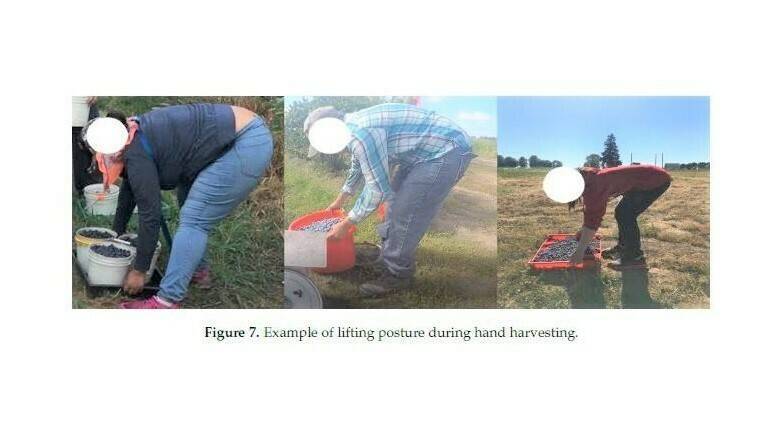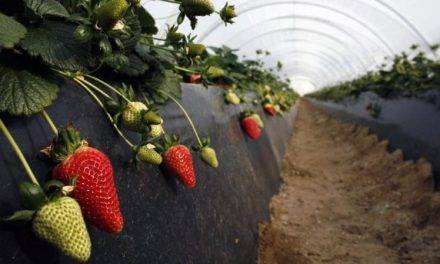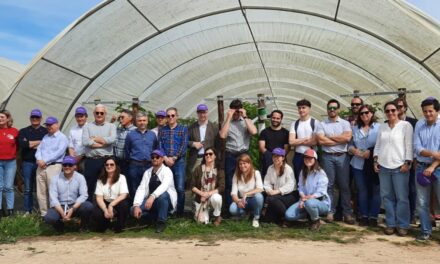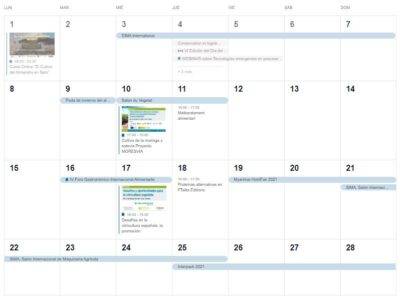
Research on the risk factors of MSDs for several types of blueberry harvesting

A study by Eunsik et al. on blueberry harvesting concludes that fully mechanized harvester would be the best approach to minimizing worker loading and fatigue; for semi-mechanical harvesting, the biggest problem with the shakers is the vibration.
Work-related musculoskeletal disorders (MSDs) accounted for 32% of days-away-from-work cases in private industry in 2016. Several factors have been associated
with MSDs, such as repetitive motion, excessive force, awkward and/or sustained postures, and prolonged sitting and standing, all of which are required in farm workers’ labor.
While numerous epidemiological studies on the prevention of MSDs in agriculture have been conducted, an ergonomics evaluation of blueberry harvesting has not yet been systematically performed.
The purpose of this study was to investigate the risk factors of MSDs for several types of blueberry harvesting (hand harvesting, semi-mechanical harvesting with hand-held shakers, and over-the-row machines) in terms of workers’ postural loads and self-reported discomfort using ergonomics intervention techniques.
Five field studies in the western region of the United States between 2017 and 2018 were conducted using the Borg CR10 scale, electromyography (EMG), Rapid Upper Limb
Assessment (RULA), the Cumulative Trauma Disorders (CTD) index, and the NIOSH (National Institute for Occupational Safety and Health) lifting equation.
In evaluating the workloads of picking and moving blueberries by hand, semi-mechanical harvesting with hand-held shakers, and completely mechanized harvesting, only EMG and the NIOSH lifting equation were used, as labor for this system is limited to loading empty lugs and unloading full lugs.
Based on the results, we conclude that working on the fully mechanized harvester would be the best approach to minimizing worker loading and fatigue. This is because the total component ratio of postures in hand harvesting with a RULA score equal to or greater than 5 was 69%, indicating that more than half of the postures were high risk for shoulder pain.
For the semi-mechanical harvesting, the biggest problem with the shakers is the vibration, which can cause fatigue and various risks to workers, especially in the upper limbs.
However, it would be challenging for small- and medium-sized blueberry farms to purchase automated harvesters due to their high cost.
Thus, collaborative efforts among health and safety professionals, engineers, social scientists, and ergonomists are needed to provide effective ergonomic interventions.
Sources
Ergonomic Evaluation of Current Advancements in Blueberry Harvesting
Eunsik Kim 1,* , Andris Freivalds , Fumiomi Takeda 3 and Changying Li 4
1 Department of Industrial & Manufacturing Systems Engineering, University of Windsor,
Windsor, ON N9B 3P4, Canada
2 Harold and Inge Marcus Department of Industrial and Manufacturing Engineering, The Pennsylvania State
University, State College, PA 16802, USA; axf@engr.psu.edu
3 United States Department of Agriculture—Agricultural Research Service, Appalachian Fruit Research
Station, Kearneysville, WV 25430, USA; fumi.takeda@ars.usda.gov
4 College of Engineering, University of Georgia, Athens, GA 30602, USA; cyli@uga.edu
* Correspondence: eskim@uwindsor.ca; Tel.: +1-519-253-3000 (ext. 5409)
Agronomy 2018, 8, 266; doi:10.3390/agronomy8110266 www.mdpi.com/journal/agronomy
Mentioned by Blueberry Consulting Newsletter.



















